|
Report from
Europe
EU27 tropical wood product imports
close to decade
high in March
EU27 import value of tropical wood and wood furniture
products was US$861 million in the first three months of
this year, 6% more than the same period in 2020.
After a slow start to the year in January and February,
imports surged to US$327 million in March, only the
second time since 2012 that monthly imports have
exceeded US$325 million (the only other occurrence being
in April 2019) (Chart 1).
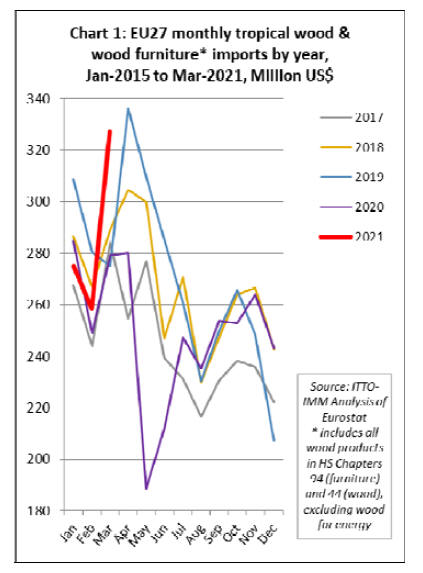
The high level of EU27 tropical wood product imports in
March came at a time when most of the continent was still
subject to tight lockdown conditions and probably partly
reflects a surge in deliveries delayed in previous months
due to shortages of containers and other logistical
problems.
However, there also encouraging signs that the economic
recovery in the EU is gaining momentum, a trend expected
to continue as vaccination rates are rising, lockdown
measures are eased and the full effects of
NextGenerationEU, the EU¡¯s large fiscal stimulus
programme, begin to be felt.
EU27 economic forecast revised upwards
According to the EU¡¯s Spring 2021 Economic Forecast
published on 12 May, following a 6.1% decline in 2020,
the EU economy will expand by 4.2% in 2021 and by
4.4% in 2022. This represents a significant upgrade of the
growth outlook compared to the Winter 2021 Economic
Forecast which the Commission presented in February.
Growth rates will continue to vary across the EU, but all
Member States should see their economies return to precrisis
levels by the end of 2022.
The Forecast notes that the rebound in Europe's economy
that began last summer stalled in the fourth quarter of
2020 and in the first quarter of 2021, as fresh public health
measures were introduced to contain the rise in the number
of COVID-19 cases. However, the rise in vaccination rates
and easing of lockdown restrictions is expected to drive a
strong rebound in private consumption and investment.
Growth is expected to be bolstered by rising demand for
EU exports from a strengthening global economy. Public
investment, as a proportion of GDP, is also set to reach its
highest level in more than a decade in 2022 driven by the
Recovery and Resilience Facility (RRF), the key
instrument at the heart of NextGenerationEU.
While the outlook is more positive, the Forecast
emphasises that the risks are high and will remain so as
long as the shadow of the COVID-19 pandemic hangs
over the economy. Developments in the epidemiological
situation and the efficiency and effectiveness of
vaccination programmes could turn out better or worse
than assumed in the central scenario of this forecast.
The forecast may underestimate the propensity of
households to spend or it may underestimate consumers'
desire to maintain high levels of precautionary savings.
The impact of corporate distress on the labour market and
the financial sector could yet prove worse than anticipated.
Forward looking indicators show that economic
momentum in the EU27 has picked up since the start of
the year, although business and consumer confidence is
still quite fragile, particularly in the construction sector, a
key driver of timber demand in the region.
The EU¡¯s consumer confidence indicator reached its
highest level in one year in March, pushing the quarterly
average up to -14.8, 1.9 points above the previous quarter.
The EU¡¯s Economic Sentiment Indicator (ESI) continued
to recover, edging up to 109.7 in April 2021, markedly
above its long-term average and higher than its prepandemic
level for the first time since the outbreak of
COVID-19 on the continent.
¡¡
Similarly, Markit¡¯s Flash Purchasing Managers¡¯
Composite Output Index for the euro area stayed above its
no change mark of 50 for a second month in a row in
April, after four months of decline. It was up by 0.5 points
to 53.7.
The IHS Markit Eurozone Construction Total Activity
Index was unchanged at 50.1 in April, signalling only a
fractional expansion in euro area construction activity for
the second successive month. Construction firms often
linked the slight expansion to a resumption of work on
paused projects and were increasingly concerned about the
impact that renewed COVID-19 restrictions have had on
overall demand in the construction sector.
According to IHS Markit, work undertaken on housing by
euro area construction firms increased for a second
successive month in April. The rate of growth quickened
from March and was the strongest recorded since February
2020.
A renewed contraction in home building activity in
Germany was offset by a survey record expansion among
Italian housebuilders. French firms, meanwhile, reported
stable conditions in housebuilding for the second month in
a row.
Commercial construction activity contracted again in the
latest HIS Markit survey period, extending the current
sequence of decline to 14 months. That said, the pace of
the reduction eased from March and was the softest in the
sequence.
A softer fall in commercial activity in France and a
stronger rise in Italy contributed to the easing in the rate of
decline. However, firms in Germany signalled a further,
marked decline in commercial building. The downturn in
euro area civil engineering activity continued in April, as
work undertaken on infrastructure projects contracted at a
modest pace.
The IHS Markit survey shows that the degree of optimism
regarding the outlook for construction activity over the
coming 12 months eased in April and was the softest
recorded for three months. German constructors signalled
renewed pessimism regarding the year ahead outlook, with
projections at their weakest since December 2020.
French firms indicated a lower level of positive sentiment,
though Italian firms signalled the strongest projections
since August 2001.
Rebound in EU27 tropical wood product imports in
first quarter
The value of EU27 imports of most tropical wood
products increased in the first three months of 2021
compared to the same period in 2020. This is encouraging
given that Europe only began to lockdown in the middle of
March last year, too late to significantly impact on trade
volumes in the first quarter of 2020.
EU27 imports of wood furniture from tropical countries
increased 7% to US$396 million in the first quarter this
year compared to the same period in 2020, while imports
of tropical sawnwood increased 3% to US$163 million,
tropical mouldings were up 6% to US$74 million, joinery
up 11% to US$43 million, plywood up 10% to US$34
million, flooring up 3% to US$15 million, and logs up
27% to US$12 million.
These gains offset a 4% decline in veneer imports to
US$44 million, and a 17% fall in marquetry imports to
US$16 million (Chart 2).
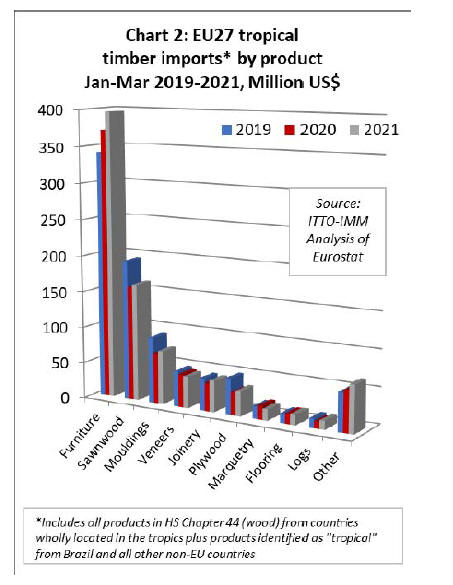
In the first quarter this year, import value increased into all
the largest EU27 destinations for tropical wood and wood
furniture products with the exception of Italy and Spain.
Import value was up 4% to US$169 million in France,
11% in the Netherlands to US$173 million, 11% in
Germany to US$147 million, 12% in Belgium to US$120
million, 30% in Denmark to US$42 million, 17% in
Poland to US$23 million, and 4% to Sweden to US$20
million. Import value decreased in Italy by 12% to US$58
million and by 11% in Spain to US$42 million (Chart 3).
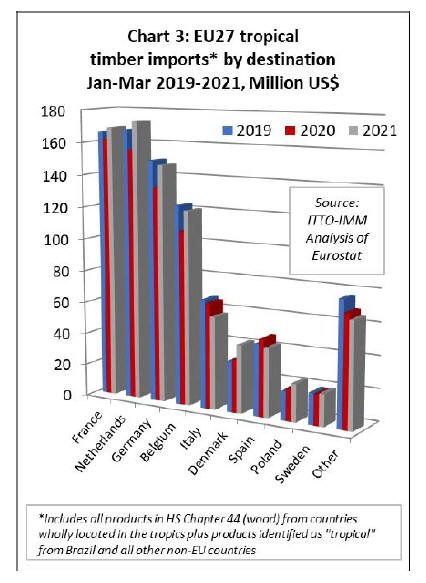
Rising EU27 wood furniture imports from India and
Malaysia
In the first three months of 2021 compared to the same
period in 2020, EU27 import value of wood furniture
increased sharply from India (+30% to US$86 million)
and Malaysia (+41% to US$35 million). However import
value from the two largest suppliers was marginally down
on the previous year¡¯s level, declining 2% from Vietnam
to US$173 million and 1% from Indonesia to US$91
million (Chart 4).
It is notable that India, until recently only a relatively
minor supplier of wood furniture to the EU, is now
challenging Indonesia as the second largest tropical
supplier of these products into the region.
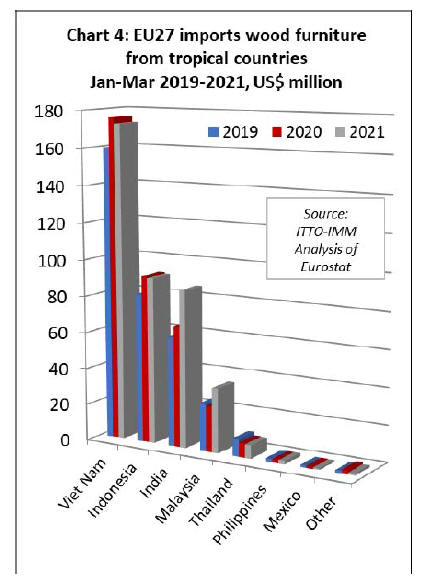
Sharp decline in sawnwood imports from Cameroon
and Malaysia
The EU27 imported 178,400 cu.m of tropical sawnwood
in the first three months of this year, 3% less than the same
period in 2020. Imports were sharply down from
Cameroon (-9% to 58,300 cu.m) and Malaysia (-38% to
13,900 cu.m), while imports from Côte d¡¯Ivoire continued
a steady decline (-6% to 5,600 cu.m).
However, there were gains in imports from Brazil (+21%
to 32,500 cu.m), Gabon (+15% to 27,800 cu.m), Republic
of Congo (+17% to 13,300 cu.m), Ecuador (+5% to 6,100
cu.m), and Ghana (+27% to 5,400 cu.m). Despite the sharp
decline in imports from Cameroon this year and last, it is
notable that the country still remains very dominant as the
lead supplier of tropical sawnwood into the EU27 (Chart
5).
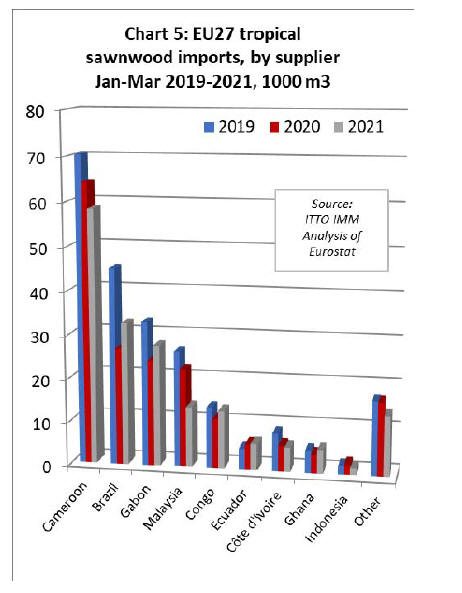
In contrast to sawnwood, EU27 imports of tropical
mouldings/decking increased in the first quarter of this
year, at 45,700 tonnes 7% more than the same period in
2020. Imports from Brazil, the largest supplier, were level
at 19,300 tonnes. Despite widespread reports of supply
shortages for Indonesian bangkirai decking, imports of
moulding/decking from Indonesia increased 24% to
16,400 tonnes during the three month period.
Imports also increased 24% to 3,400 tonnes from Peru and
11% to 1340 tonnes from Gabon. These gains offset a 26%
decline in imports from Malaysia to 1600 tonnes, and a
26% fall from Bolivia to 1,300 tonnes (Chart 6).

EU27 imports of tropical logs, which have been in long
term decline and are now a shadow of their former level,
did at least rebound 9% to 22,000 cu.m in the first three
months of this year. Imports recovered from the leading
African supply countries but imports from South
American countries, which had increased sharply last year,
fell back to negligible levels.
Imports increased 38% to 9,100 cu.m from the Republic of
Congo, 52% to 4,200 cu.m from CAR, 8% to 2000 cu.m
from Cameroon, 5% to 2,000 cu.m from DRC, and 7% to
2,600 cu.m from Liberia. In contrast, imports from
Paraguay fell 85% to just 236 cu.m and from Guyana were
down 27% to 360 cu.m (Chart 7).

Slow start to the year for imports of tropical veneer
and plywood
EU27 imports of tropical veneer declined 4% to 64,900
cu.m in the first three months of this year. After a rapid
rise last year, imports from Gabon declined 1% to 33,500
cu.m. There were larger falls in imports from Côte d'Ivoire
(-7% to 14,500 cu.m), Ghana (-7% to 1,800 cu.m),
Equatorial Guinea (-78% to 900 cu.m), and Indonesia (-
17% to 1,537 cu.m).
However, imports increased 13% to 4,700 cu.m from
Cameroon and 32% to 5,900 cu.m from the Republic of
Congo (Chart 8).
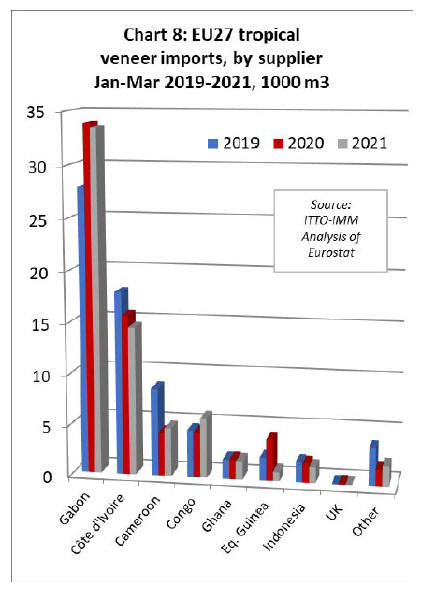
After a slow year in 2020, EU27 imports of tropical
plywood made only marginal gains in the first quarter of
this year. Imports of 51,500 cu.m in the three month
period were just 2% more than in the same period in 2019.
Imports were up from all four of the largest supply
countries including Indonesia (+6% to 16,200 cu.m),
China (+2% to 14,500 cu.m), Gabon (+29% to 8,000
cu.m), and Vietnam (+14% to 2,100 cu.m).
However, the decline in imports continued from Brazil (-
40% to 1,100 cu.m) and Malaysia (-37% to 875 cu.m.).
EU27 imports of tropical hardwood plywood from the UK
¨C a re-export since the UK has no plywood manufacturing
capacity ¨C fell 35% to 2,000 cu.m (Chart 9).

Tropical flooring imports rise while other joinery
imports decline
After unexpectedly recovering some lost ground last year,
EU27 imports of flooring from tropical countries have
weakened again this year. Imports of 4,900 tonnes in the
first three months were 6% less than the same period in
2020. Imports from Malaysia continued to rise, up 16% to
2,300 tonnes, while imports from Vietnam recovered by
13% to 730 tonnes.
However, these gains were offset by a 23% decline in
imports from Indonesia to 1,200 tonnes and a 47% decline
in imports from Brazil to just 360 tonnes. (Chart 10).
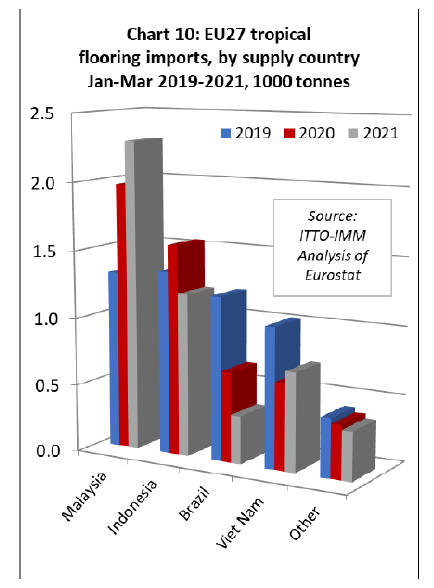
The value of EU27 imports of other joinery products from
tropical countries - which mainly comprise laminated
window scantlings, kitchen tops and wood doors -
increased 11% to US$43 million in the first three months
of this year.
Imports were up 22% to US$21.7 million from Indonesia,
6% to US$13.8 million from Malaysia, and 41% to
US$4.2 million from Vietnam (Chart 11).
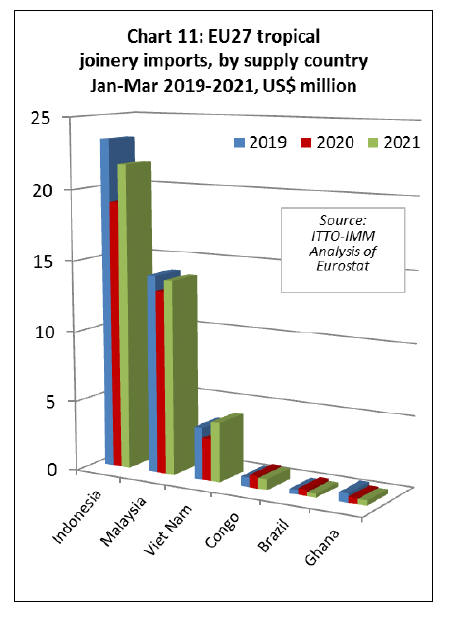
Latest on EU policy framework for ¡®forest-risk¡¯
commodities
Speaking at a webinar hosted by the EURACTIV news
agency on 26 May, Virginijus Sinkevičius, EC
Commissioner for Environment, Oceans and Fisheries,
provided an update on the state of play in EU deliberations
on a new policy framework to ensure EU consumption is
not contributing to global deforestation and forest
degradation.
See:
https://events.euractiv.com/event/info/eu-agenda-for-globalforests-getting-the-balance-right
The Commissioner reiterated the EU¡¯s intention to
develop new laws to prevent commodities with a high risk
of contributing to deforestation being placed on the EU
market.
The EU is also likely to propose that these new laws be
implemented alongside new partnerships with countries
supplying ¡°forest risk¡± commodities to develop procedures
to ensure that products are ¡°deforestation free¡±.
¡¡
The Commissioner began by emphasising that the whole
issue of deforestation is ¡°high on the political agenda, it's
very high on the Commission's agenda, it's an important
matter for companies, NGOs and of course citizens, and
it's a key topic for everyone on the ground in the
producing countries¡± and noted that ¡°tackling
deforestation is an important element in [the] European
Green Deal¡± (which sets out the trajectory for the EU to be
climate neutral by 2050).
The Commissioner said that the intention was to build on,
and learn from, existing forest policy mechanisms,
particularly those implemented as part of the FLEGT
Action Plan.
He noted that ¡°part of the process to develop a new
legislative proposal is an evaluation of the effectiveness of
existing legislation; a fitness check of both the EU Timber
Regulation and the FLEGT Regulation with its Voluntary
Partnership Agreements¡±. He also said the EC is
¡°conducting a study on the role and impact of private
certification schemes, and the contributions they could
make to additional measures¡±.
Commenting on the role of the EUTR, the Commissioner
said that ¡°a mixed picture is emerging; it has been an
incentive for operators to focus on keeping their supply
chains clean, but the structure and the wording of the
legislation has made it difficult to use in practice. The
[EUTR] competent authorities found it hard to prove due
diligence compliance failures in courts of law. In that area
there is definitely room for improvement¡±.
On the role of the VPAs, the Commissioner said that these
¡°have clearly proved their use in improving stakeholder
participation, better forest governance and regulatory
reforms in some partner countries, but their actual impact
on illegal logging and associated trade has been more
limited. We have not found much evidence that these
agreements have helped reduce illegal logging or the
consumption of illegally harvested wood here in Europe¡±.
The Commissioner emphasised that this was not intended
as a criticism of progress made in any individual VPA but
rather the ¡°problem is simply one of scale; the first VPA
was concluded with Ghana more than a decade ago, but
today when we have 15 different VPAs at various stages
of completion, there is only one operating licencing
system in place in Indonesia. That means that despite our
best efforts, these agreements cover only a very small part
of the overall volume of trade. So the total effect on illegal
timber is therefore extremely limited¡±.
The Commissioner went to say that ¡°these conclusions
together with the feedback from extensive public
consultations, input from the European Parliament, and
studies we have carried out, are quite clear. The current
system of due diligence needs to be improved and
enhanced, but that alone will not be enough¡±.
According to the Commissioner, ¡°enhanced¡± due diligence
¡°will need to be complemented by alternative support
methods which help partner countries to comply with the
requirements¡±. He indicated that there would be a more
flexible approach to development of forest partnership
agreements so that they are ¡°tailored to specific needs and
the specific interests of each partner country¡±.
This implied that the agreements ¡°should retain the
elements that have proved effective, while other
[elements], like licencing in a trade agreement, should be
abandoned.¡± Perhaps hinting at a shift towards more
jurisdictional forms of verification based on analysis of
governance and assessment of forest condition at national
or regional level, he noted that ¡°we are also creating an
EU Observatory which will facilitate information
exchange on global deforestation, combining trade data
with [satellite] observation¡±.
In finalising their regulatory proposals, the Commissioner
said ¡°we need to be certain that all options comply with
our obligations under the World Trade Organisation
rules¡we started with a long list of 20 options, now we
are down to a few ones such as improved due diligence
requirements, country benchmarking, mandatory public
certification, mandatory labelling, or a deforestation free
requirement¡±.
He also said that the EC identified a ¡°preliminary list of
products, the main criteria for choosing them [being] the
overall impact of production and harvesting on forests and
their level of consumption in the EU, so that list includes
for now palm oil, cattle, soy, wood, cocoa and coffee¡±.
The Commissioner concluded that ¡°we have come a long
way since the first commission proposal in its 2019
communication [on Stepping up EU Action to Protect and
Restore the World's Forests]. Under the Green Deal we are
advancing steadily and we are advancing with care. We
have no choice but of course to get it right. And for that to
happen, we need to listen to the views from all sides¡±.
|